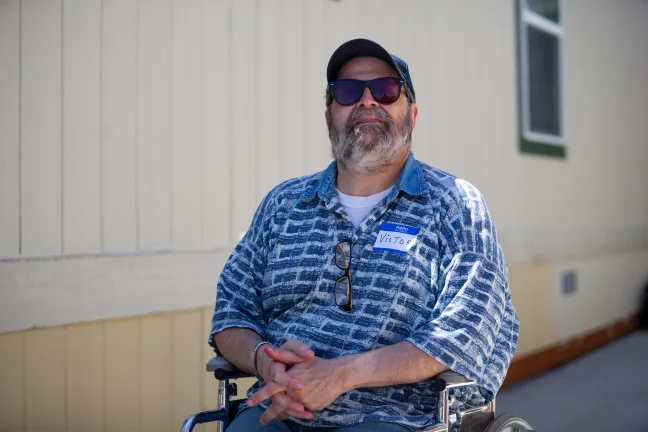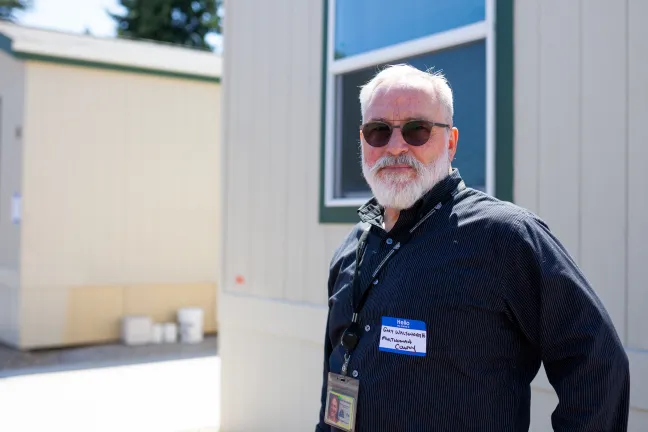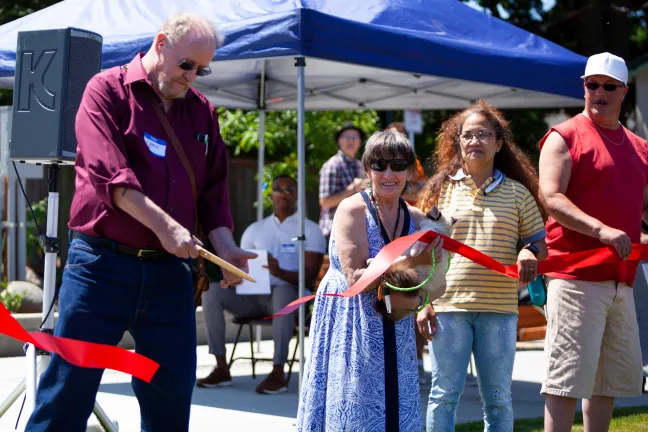When Victor Johanson’s blue, metal RV was built in 1968, the Beatles were still together and recording their “white album.” But the RV hasn’t been renovated since. He couldn’t get into the bathroom with his wheelchair, the windows hadn’t been opened in 10 years, and buckets were collecting water from the ceiling.
And that was the least of his problems.
In 2016, Johanson learned the owner of Oak Leaf Mobile Home Park, the place he and nearly 60 other residents called home, was planning to sell the property to a developer.
“It can be talked about in just one word: fear,” Johanson said. “What we were looking forward to having to do was being put out on the street. That could have been me. That could have been any one of the residents here.”
In recent decades, mobile home communities have become a massive part of Oregon’s affordable housing stock. There are currently 60,000 mobile homes across the state, but it’s been years since a new mobile home park has been built. Thousands of people have lost their homes to mobile park closures.
Facing the same fate, Johanson and his neighbors organized themselves. They reached out to Living Cully, and CASA of Oregon, a housing nonprofit. They began speaking out at Portland City Council meetings.
Eventually, a coalition of nonprofit and government partners worked together to buy the park. It finally landed in the possession of St. Vincent de Paul of Lane County, who has been working to protect mobile home communities along the Interstate 5 Corridor. But still, something had to be done about the dilapidated trailers and RVs.
That’s where Multnomah County came in.
Multnomah County steps forward to protect Oak Leaf
Gary Walsworth, a program specialist for the County’s Weatherization Program, remembers visiting Oak Leaf for the first time. He was immediately concerned for the residents’ safety.
“You had trailers, RVs, campers, and these were vehicles that were not roadworthy,” he said. “You had pre-1976 mobile homes with holes in the floor. They weren’t just in bad shape, they were in dangerous shape.”
The Weatherization Program serves Multnomah County residents with limited incomes by renovating their homes and making them more energy efficient. The program also saves people money on their energy bills and improves indoor air quality.
Walsworth says the majority of Weatherization’s clients live in mobile homes. They make up a significant portion of affordable housing options Multnomah County, and the team routinely weatherizes multiple homes in a single park.
“There are thousands of mobile home units in Multnomah County,” he said. “Our job is to weatherize people’s homes and this is where people live.”
But simply weatherizing the Oak Leaf residents’ homes wasn’t feasible. They weren’t just energy inefficient. They were uninhabitable. So leaders got creative. The program put forward $400,000 to help purchase and install 20 new two-bedroom, one-bathroom Northwest Energy Efficient Manufactured Homes to replace the residents’ previous unsafe, inefficient homes.
“People here wanted to stay here,” Walsworth said. “This is their home. My job was to do what I could to keep them in their community.”
Under the leadership of St. Vincent de Paul, crews spent nine months redeveloping the park and installing 22 spaces of affordable housing. They also built a one-story community center with a common laundry room and on-site leasing and counseling offices. A playground now sits in the middle of the park.
Walsworth says Oak Leaf has been completely transformed — an example of how governments and nonprofits can preserve people’s homes.
“We had to do something about it,” Walsworth said. “I felt bad for the people living in those conditions, but it was their home. There was no alternative. This is clearly an investment that helps people who need help the most.”
Oak Leaf residents welcomed home
On July 20, 2019, residents and community partners gathered to celebrate the project’s completion. There was live music and food on the grill, and guests toured models of the new homes. A panel of speakers, including Johanson and another resident, Rhonda Polk, shared on stage what the project meant for them.
When Polk first moved to Oak Leaf with her two kids, she feared for their safety. But it was all she could afford. Once she found out it was being sold, she joined the fight to preserve the community.
“The whole point of all that fighting was to see this today and how amazing that it has become,” Polk said. “Today we stand here in this amazing park and we have brand new places to live and places that we can be proud of.”
After all the applause, the celebration and a ribbon-cutting ceremony, Johanson took a moment for himself in front of his future home. He’s been living in a motel room while crews worked to replace his old trailer. Contractors were working on the finishing touches and getting ready to install a wheelchair ramp.
His new home is at least five times more efficient and expected to last 60 more years. His move in date was just days away. Looking at the new windows and fresh paint, he couldn’t help but think about how far they had come.
“Now, it’s not an old beat-up trailer,” he said. “It’s brand new. We couldn't picture that this was what Oak Leaf could look like. None of us dreamed it could be this way.
Special thanks to the project partners:



